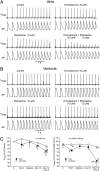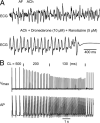Synergistic effect of the combination of ranolazine and dronedarone to suppress atrial fibrillation
- PMID: 20883928
- PMCID: PMC2951276
- DOI: 10.1016/j.jacc.2010.08.600
Synergistic effect of the combination of ranolazine and dronedarone to suppress atrial fibrillation
Abstract
Objectives: The aim of this study was to evaluate the effectiveness of a combination of dronedarone and ranolazine in suppression of atrial fibrillation (AF).
Background: Safe and effective pharmacological management of AF remains one of the greatest unmet medical needs.
Methods: The electrophysiological effects of dronedarone (10 μmol/l) and a relatively low concentration of ranolazine (5 μmol/l) separately and in combination were evaluated in canine isolated coronary-perfused right and left atrial and left ventricular preparations as well as in pulmonary vein preparations.
Results: Ranolazine caused moderate atrial-selective prolongation of action potential duration and atrial-selective depression of sodium channel-mediated parameters, including maximal rate of rise of the action potential upstroke, leading to the development of atrial-specific post-repolarization refractoriness. Dronedarone caused little or no change in electrophysiological parameters in both atrial and ventricular preparations. The combination of dronedarone and ranolazine caused little change in action potential duration in either chamber but induced potent use-dependent atrial-selective depression of the sodium channel-mediated parameters (maximal rate of rise of the action potential upstroke, diastolic threshold of excitation, and the shortest cycle length permitting a 1:1 response) and considerable post-repolarization refractoriness. Separately, dronedarone or a low concentration of ranolazine prevented the induction of AF in 17% and 29% of preparations, respectively. In combination, the 2 drugs suppressed AF and triggered activity and prevented the induction of AF in 9 of 10 preparations (90%).
Conclusions: Low concentrations of ranolazine and dronedarone produce relatively weak electrophysiological effects and weak suppression of AF when used separately but when combined exert potent synergistic effects, resulting in atrial-selective depression of sodium channel-dependent parameters and effective suppression of AF.
Copyright © 2010 American College of Cardiology Foundation. Published by Elsevier Inc. All rights reserved.
Figures






References
-
- Piccini JP, Hasselblad V, Peterson ED, et al. Comparative efficacy of dronedarone and amiodarone for the maintenance of sinus rhythm in patients with atrial fibrillation. J Am Coll Cardiol. 2009;54:1089–95. - PubMed
-
- Touboul P, Brugada J, Capucci A, et al. Dronedarone for prevention of atrial fibrillation: a dose-ranging study. Eur Heart J. 2003;24:1481–7. - PubMed
-
- Singh BN, Connolly SJ, Crijns HJ, et al. Dronedarone for maintenance of sinus rhythm in atrial fibrillation or flutter. N Engl J Med. 2007;357:987–99. - PubMed
-
- Kober L, Torp-Pedersen C, McMurray JJ, et al. Increased mortality after dronedarone therapy for severe heart failure. N Engl J Med. 2008;358:2678–87. - PubMed
-
- Hohnloser SH, Crijns HJ, van Eickles M, et al. Effect of dronedarone on cardiovascular events in atrial fibrillation. N Engl J Med. 2009;360:668–78. - PubMed
Publication types
MeSH terms
Substances
Grants and funding
LinkOut - more resources
Full Text Sources
Other Literature Sources
Medical

